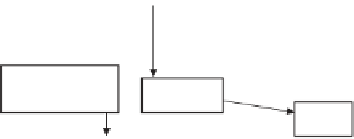Agriculture Reference
In-Depth Information
propionate : butyrate ratio from starch fermentation is
55 : 25 : 15.
Secondary groups of rumen bacteria convert formate to
methane and lactic acid or other acids to propionate.
Secondary fermenters have lower metabolic rates, higher
generation intervals (16 hours), and a higher optimum pH
(6.2-6.8) than amylolytic bacteria. Therefore, when an
animal is abruptly transferred to high concentrate diet,
rapid fermentation often leads to high acid (lactic acid)
production and a rumen pH lower than optimum for amy-
lolytic bacteria but too low for secondary fermenters.
Hydrogen disposal is hindered, acids accumulate, and
clinical or subclinical rumen acidosis can occur.
Dietary Protein
Nonprotein Nitrogen
UIP/RUP
DIP/RDP
Dietary plant amides,
nitrites, nitrates
Endogenous salivary urea
Salivary
Glands
Peptides
Amino Acids
NH
4
Blood
Microbial
Protein
Liver
Kidney
Lower Tract
Figure 8.3
Protein and nonprotein nitrogen
metabolism in the rumen.
UIP = undegraded intake protein;
RUP = ruminally undegradable protein.
DIP = degradable intake protein;
RDP = ruminally degradable protein.
F
ERMENTATION
OF
P
ROTEINS
Proteolytic bacteria represent a small portion (12-38%) of
total reticulo-rumen bacterial mass and are responsible for
ammonia production. Ammonia is required for growth of
many cellulolytic and amylolytic bacteria. Peptides, amino
acids, and isoacids may be stimulants for their growth and
activity. The main dietary substrate for this group of
bacteria is dietary protein that can be divided into two
classes: ruminally degraded protein (RDP) or degraded
intake protein (DIP) and ruminally undegraded protein
(RUP) or undegraded intake protein (UIP). The later gen-
erally passes to the lower tract undegraded by rumen
microorganism. Generally about half of the dietary protein
is degraded in the rumen. Extracellular proteases from
bacteria degrade dietary protein to yield peptides, amino
acids, and ammonia. Amino acids can be used by some
ruminal microbes, but most can synthesize their own
amino acids from ammonia. When protein supply is high,
bacteria readily degrade it yielding ammonia and various
metabolic acids. Amino acids are deaminated to keto
acids that are fermented to VFA and small amounts of
the branched chain VFA—isobutyrate, iso valerate, and
2-methylbutyrate—that arise from valine, leucine, and
isoleucine, respectively. Dietary plant amides, nitrites and
nitrates, and endogenous salivary urea (nonprotein nitro-
gen compounds) when fermented also yield ammonia.
Bacterial urease activity is high in the reticulo-rumen
and readily converts dietary or recycled urea to ammonia.
Urea is an important substrate for microbial protein syn-
thesis. The capacity of rumen microbes to use ammonia
and convert it to microbial protein depends on the avail-
ability of energy, largely from carbohydrate fermentation.
The greater the supply of fermented carbohydrate, the
greater the ammonia uptake and synthesis of bacterial
mass.
Conversion of peptides via amino acids to ammonia is
a slow process of oxidative deamination of amino acids.
This process requires the transfer of hydrogen via NADH.
Ionophores inhibit proteolytic activity in the rumen either
through inhibiting transfer of hydrogen needed for deami-
nation of amino acid and ammonia formation, or by altera-
tion of rumen microfl ora. Because peptides and amino
acids are degraded in the rumen, fl ow of nitrogen to the
abomasum and intestines consists largely of undegraded
dietary protein and microbial protein (Figure 8.3).
Diet formulators seek to balance the supply of readily
available carbohydrates and proteins in the diet to ensure
that an adequate supply of ammonia (for protein synthesis)
and carbohydrate (for energy) are available for microbial
protein synthesis but to avoid excessive protein that will
be wasted. Excessive production of ammonia, particularly
from nonprotein nitrogen (esp., urea) will increase the risk
of ammonia toxicity. Energetically, protein degradation in
the rumen is wasteful, and for the animal, energy is
required to convert ammonia to urea within the liver and
for the kidneys to excrete urea.
F
ERMENTATION
OF
L
IPIDS
Ruminants fed forage-based diets typically consume only
a small amount (3-7% dry matter [DM]) of structural
lipids in the plant leaves. The majority of these lipids are
phospholipids and galactolipids with less than 50% being


















